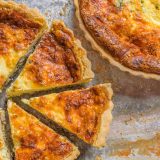Every fall, when I visit Seattle while on book tour, I stop for lunch at Le Pichet, the model of a small French neighborhood restaurant. The menu is purposely limited—saucissons and plates of charcuterie, gâteau au foie de volaille (chicken liver terrine), tartines, broiled eggs with ham and Gruyère, raclette, oysters, gratin Lyonnais (Lyon-style French onion soup) and, on most days, quiche.
Le Pichet has a scattering of tables on the sidewalk, and the floor is patterned black and white tiles. The bar (I sit just behind the espresso machine) appears to be made of zinc. It reminds me of the bar in one of my favorite Paris eateries, Le Rubis, which also has a limited menu, house wines and low prices. You don’t come to Le Pichet to be seen or to hobnob. You come here to eat very good food, drink good cheap wine and enjoy the company of whomever you happen to be with. (In my case, that would be the server.)
For years I spied quiche on the menu but instead chose dishes further afield, seasonal specialties to expand my culinary education with items such as buttermilk-fried pork tongue on a bed of shredded carrots. Then, one year, I ordered eggs with ham and Gruyère with a half baguette and two glasses of Côtes du Rhône and remembered how I had fallen in love with French cooking during a family vacation to Paris in 1967. Embarrassed by the formal tours organized by Monsieur and Madame Kimball, I played hooky and ended up at a Left Bank restaurant, almost identical to Le Pichet, where I ordered my first glass of house wine, duck breast with lentils, and pineapple sorbet for dessert. I managed to mumble something about “l’addition” (the bill), figured out the franc-dollar conversion and left an outsize tip as a thank you for treating me like an adult, not some sneakered teenager.
Rich yet airy, Le Pichet's indulgent deep-dish quiche defies gravity.
But I digress. During my next visit to Le Pichet, I went for the quiche and found myself face to face with a mile-high slice of custard pie, stuffed with mushrooms, lardons and Gruyère. It was both creamy and rich, trembling and light, held together by a sturdy crust that shattered then melted in the mouth. The genius of this recipe was the marriage of rich cream and light texture—it never felt greasy or heavy in the mouth; it slid down the gullet with barely a whisper of overindulgence. Not health food, of course, but healthy food—a dish that perfectly suits its purpose without excess while delivering pleasure beyond its ingredients.
Le Pichet’s pastry chef was kind enough to send the recipe and, at first glance, I was taken aback by the calorie count (crème fraîche, heavy cream, eggs and Gruyère). But I soon discovered that there was something about the crème fraîche that lightened the load. I am at a loss to explain the science of this mixture, but the crème fraîche was adding more than tang; it was defying gravity by loosening the texture and providing the sensation of airiness while delivering a punch of Gruyère and, in our case, tarragon and Canadian bacon. It also helped that the ratio of eggs to dairy was high (12 eggs per 3 cups dairy) and the recipe was easy on the cheese. There are times in life when one is becalmed by quiet desperation and only a slice of quiche will do. Well, here you are.
At Milk Street, we fiddled with ratios and ended up with six eggs to 2½ cups dairy and used 6 ounces of Gruyère, a modest amount to keep things light. Yes, you can substitute store-bought pie pastry if you must (take two crusts, press them together, fold into quarters, shape into a 6-inch round and refrigerate before rolling), but you might as well go all in. This is not indulgence; this is self-indulgence that includes the joy of making the thing in the bargain. Half measures do not yield culinary joy.





